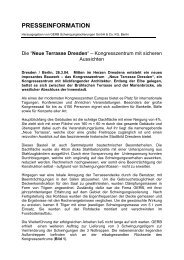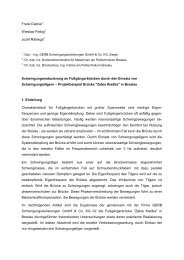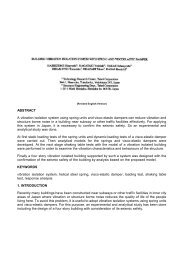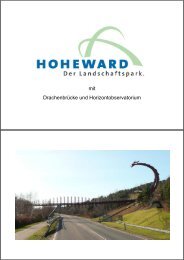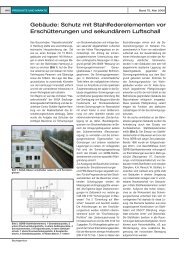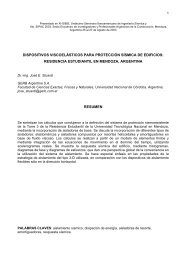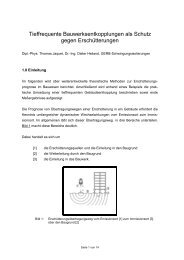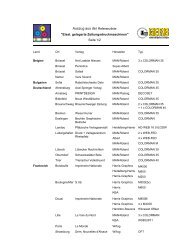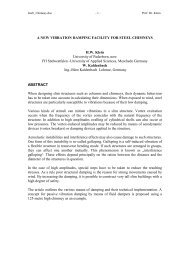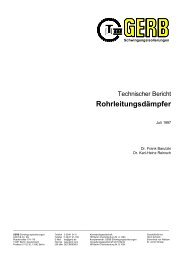Vibration suppression of a 90-m-tall steel
Vibration suppression of a 90-m-tall steel
Vibration suppression of a 90-m-tall steel
You also want an ePaper? Increase the reach of your titles
YUMPU automatically turns print PDFs into web optimized ePapers that Google loves.
In the second stage, three viscous dampers were attached to the pendulum system, and free vibration<br />
test was carried out for this complete TMD configuration. It was found that, within the amplitude<br />
range <strong>of</strong> interest, the damping ratio was raised from 1–3 % to about 30 – 45 %, and the vibration<br />
frequency was also shifted from 0.61 – 0.67 Hz to about 0.78 – 0.88 Hz. The frequency shift could be<br />
explained by the fact that the viscous dampers generated not only viscous forces but also elastic<br />
forces; the dampers exhibited viscoelastic effect.<br />
In the third and fourth stage, free vibration tests were carried out after the construction <strong>of</strong> the stack<br />
was completed and TMD was ins<strong>tall</strong>ed on its top as designed. Acceleration sensors were placed on<br />
both stack and TMD. However, in the third stage the <strong>steel</strong> ring <strong>of</strong> TMD was locked such that it could<br />
not move relative to the stack; this was to check the dynamic properties <strong>of</strong> the stack. The sway motion<br />
<strong>of</strong> the stack was first induced by asking several people on the top platform to move their bodies back<br />
and forth in a synchronized manner at a frequency close to the estimated natural frequency. After a<br />
sufficiently high vibration amplitude had reached, these people were asked to stop moving their<br />
bodies, and the free vibration <strong>of</strong> the stack was measured and recorded. The vibration frequency and<br />
damping ratio <strong>of</strong> the stack were found to be 0.74 Hz and 0.7 %, respectively. After correcting for<br />
added masses <strong>of</strong> the ring and people, the natural frequency <strong>of</strong> the stack alone was estimated to be 0.80<br />
Hz, which was close to the computed value from FEM analysis.<br />
In the fourth stage, TMD was unlocked, and the same free vibration test was repeated. Comparing to<br />
the previous stage, the decay <strong>of</strong> stack’s motion is much faster as shown in Figure 6. The effective<br />
damping <strong>of</strong> the stack with TMD computed from this response was about 3.6 – 4.5 %, which was less<br />
than the expected figure—5 %, but it was high enough to prevent fatigue damage and extend the<br />
service life to an acceptable level.<br />
Acceleration, g<br />
0.20<br />
0.10<br />
0.00<br />
-0.10<br />
W ith unlocked TM D<br />
W ith locked TM D<br />
-0.20<br />
0 5 10<br />
Time, seconds<br />
15 20<br />
Figure 6 Free vibration responses <strong>of</strong> the stack with locked TMD and with unlocked TMD<br />
In the fifth and sixth stages, the responses <strong>of</strong> the stack with locked TMD and with unlocked TMD<br />
under natural wind excitation were measured in order to check the control performance in normal<br />
service conditions. The autocorrelation function <strong>of</strong> the random acceleration response <strong>of</strong> the stack in<br />
both stages looked like a cosine function <strong>of</strong> time with exponentially decreasing amplitude as expected.<br />
The decay rates showed that the effective damping <strong>of</strong> the stack increased from 0.5 % when TMD was<br />
locked to about 3.0% after TMD was unlocked. The effective damping was slightly lower than that<br />
obtained from free vibration tests. The difference was probably due to the fact that the level <strong>of</strong><br />
measured random responses was much lower than the level <strong>of</strong> free vibration responses (compare<br />
Figure 6 with Figure 7).




